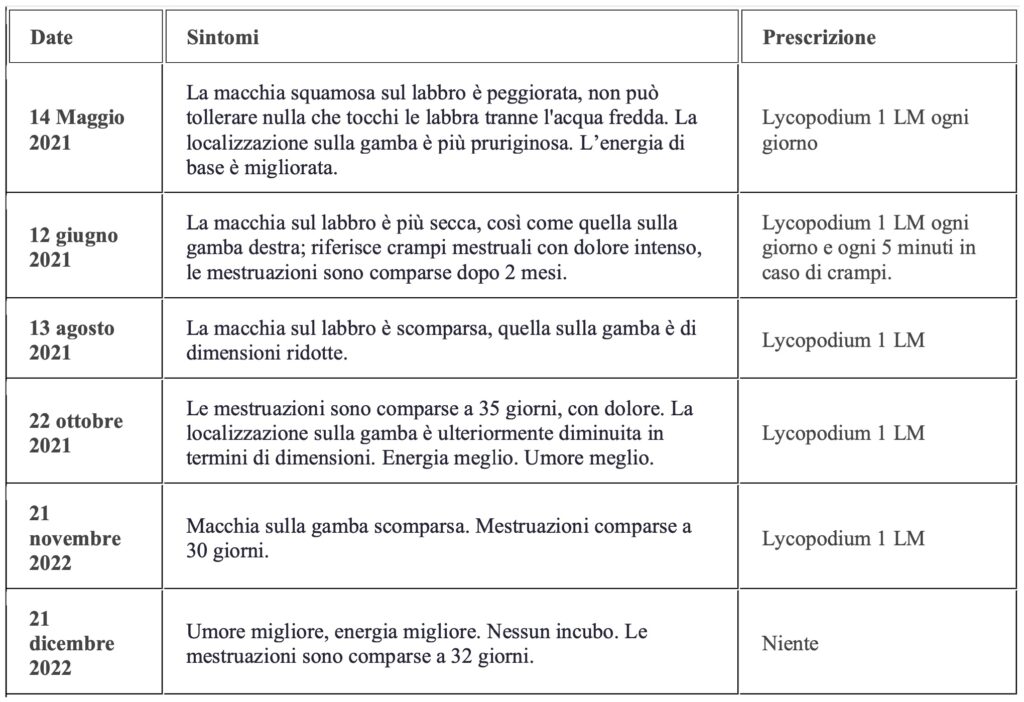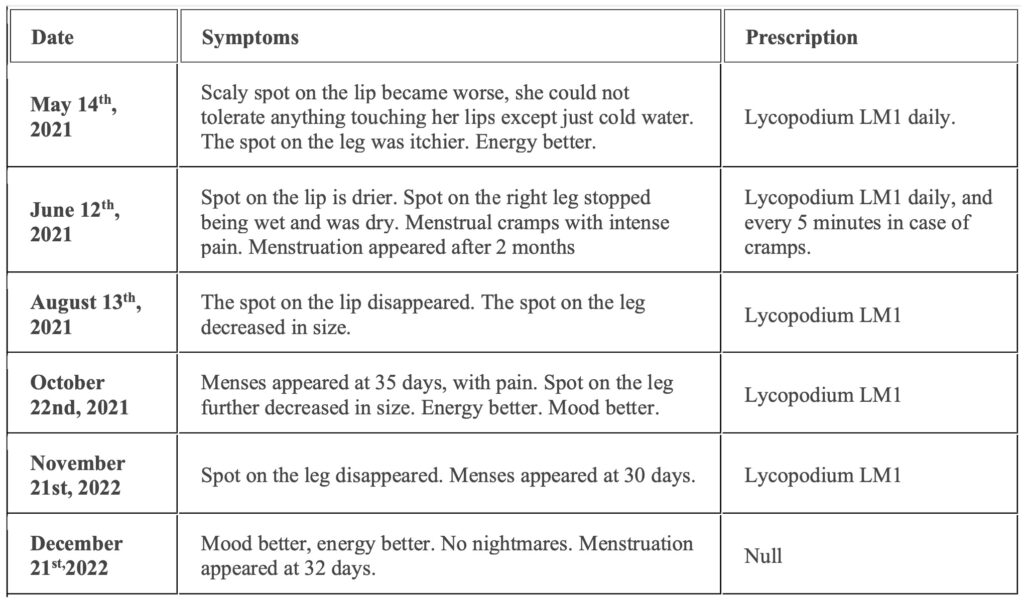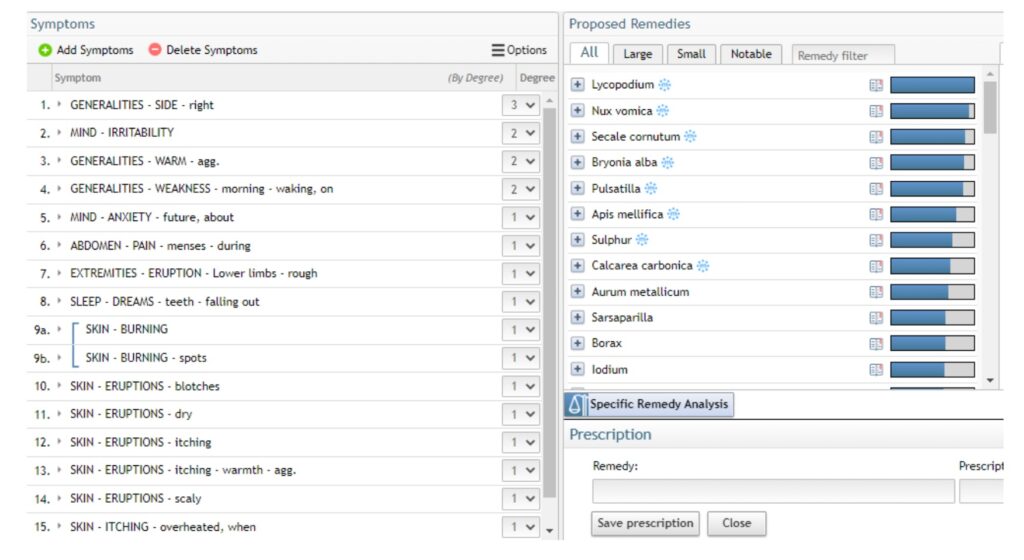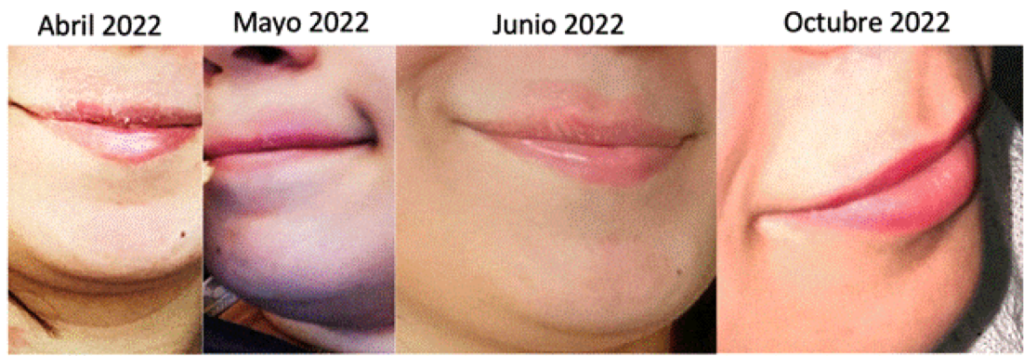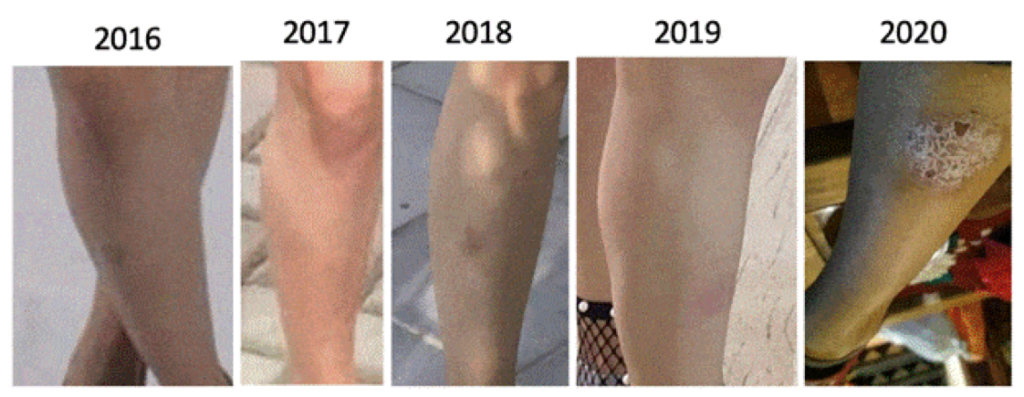Un caso di Psoriasi curato con l’Omeopatia classica
Medico Chirurgo – Messico
maria.fernanda.homeopatia@gmail.com
Redatto da Paolo Pifferi
Medico omeopata – Livorno
Vice Presidente LMHI
paolopiff95@gmail.com
Lavoro presentato al 76° Congresso Mondiale di Omeopatia LMHI – Bogotà, 24-28 Ottobre 2023
SUMMARY
Psoriasis and is one of the most prevalent autoimmune chronic inflammatory skin diseases. For patients with moderate to severe plaque psoriasis, topical agents remain the mainstay of treatment, but on the other side for severe psoriasis, biological treatments with serious side effects are the main option.
Here we present a case of psoriasis in a 23-year-old female, who responded favorably to the homeopathic remedy Lycopodium clavatum. Her lesions disappeared in 9 months of treatment, after being active for 12 years. Larger studies are needed to determine the benefit from classical homeopathy in psoriasis.
KEYWORDS
Psoriasis – Classical Homeopathy – Auto immunity – Lycopodium clavatum
RIASSUNTO
La psoriasi è una delle malattie infiammatorie croniche autoimmuni della pelle più diffuse. Per i pazienti con psoriasi a placche da moderata a grave, gli agenti topici rimangono il cardine del trattamento, ma per la psoriasi grave, i trattamenti biologici rappresentano l’opzione principale, con gravi effetti collaterali.
Presentiamo qui un caso di psoriasi in una donna di 23 anni, che ha risposto positivamente al rimedio omeopatico Lycopodium clavatum. Le sue lesioni sono scomparse in 9 mesi di trattamento, dopo essere state attive per 12 anni. Sono comunque necessari studi più ampi per determinare il beneficio dell’Omeopatia Classica nella psoriasi.
PAROLE CHIAVE
Psoriasi – Omeopatia Classica – Malattia autoimmune – Lycopodium clavatum
PSORIASIS VULGARIS TREATED WITH CLASSICAL HOMEOPATHY
INTRODUCTION
Psoriasis is a chronic inflammatory skin disease that develops in the background of a genetic inheritance. It is characterized by sharply demarcated erythematous plaques with a whitish scale1. Recent studies have shown that the pathogenesis of the disease is related substantially to TNF a, dendritic cells, and T-cells activity. There may also be related environmental triggers, such as beta-hemolytic streptococcal infections2.
Several clinical phenotypes of psoriasis are recognized, with chronic plaque (Psoriasis Vulgaris) accounting for 90% of cases. Comorbidities of psoriasis are attracting interest and include impairment of quality of life and associated depressive illness, cardiovascular disease, and seronegative arthritis known as psoriatic arthritis2.
The prevalence of psoriasis varies with the country, and psoriasis can appear at any age, suggesting that ethnicity, genetic background, and environmental factors affect its prevalence. Genetic factors play a significant role in the pathogenesis of psoriasis.
In genetically predisposed individuals, various triggering factors can elicit the disease. In past surveys from 1982 to 2012, the exacerbating factors for the Japanese population were observed to be stress (6.4% to 16.6%), seasonal factors (9.7% to 13.3%), infection (3.5% to 8.3%), sun exposure (1.3% to 3.5%), and β-blockers (0.9% to 2.3%)3.
The common comorbidities included hypertension (1.1% to 27.8%), diabetes mellitus (DM) (7.0% to 13.9%), cardiovascular diseases (4.2% to 8.1%), and tonsillitis (3.5% to 5.4%)3.
For patients with mild psoriasis, topical agents remain the mainstay of treatment, and they include topical corticosteroids, vitamin D analogs, calcineurin inhibitors, and keratolytic. The American Academy of Dermatology-National Psoriasis Foundation guidelines recommends biologics as an option for first-line treatment of moderate to severe plaque psoriasis because of their efficacy in treating it and acceptable safety profiles. Specifically, TNF-α inhibitors include etanercept, adalimumab, certolizumab, and infliximab4.
Immunosuppression being the main idea behind conventional therapy, alternative therapies have been sought to overcome its shortcomings. Classical homeopathy has been extensively applied for psoriasis, with success5. We present another such case that can enrich this body of literature.
CASE REPORT
Patient: Mexican female, 23 years old
Diagnosis: Psoriasis vulgaris.
Symptoms: Scaly spot on the right leg that increased over time, a scaly spot on the lips. on the right side.
Medication: Halcinonide and Fluocinolone creams (topical steroids)
The patient complained about a scaly spot on the right leg that increased over time, and a scaly spot on her lips on the right side. The psoriasis was present from birth and she had moments of exacerbation throughout her life. She had several stress factors over the last 2 years, including the COVID-19 and influenza vaccines.
The itching aggravated with heat and was
better by cold. The spot on the lips was aggravated by drinking hot drinks and ameliorated by drinking cold beverages. The spots burned and were dry, with itching in stressful situations leading to scratching until she bled.
Another complaint was lack of energy in the morning, even though she sleeps 6-7 hours at night. Her menstruation was irregular and very painful. The patient also mentioned that she was always sick in her stomach, never able to feel quite right about eating because she was bloated or had loose stools. She had a strong desire for chocolate and sweets.
In the mental and emotional area, the patient complained about irritability, anxiety about not being in control of things, and anxiety about the future. She was afraid of the future, and fear of new situations. Usually had nightmares about her teeth or hair falling out, and the death of loved ones.
History revealed that she was born with a scaly spot on the face, scalp, and groin (all of them on the right side). The scaly spots on the scalp and head were present from birth to 6 years age. The one from the right groin was present from 6 to 12 years age. And the actual spot in the right leg is from 12 years age onwards.
The lesion on the lips is active since April 2020, after the COVID-19 vaccine. She had Hepatitis B at the age of 5 years, when she remembers bleeding from her ears. The doctors gave her a slim chance of survival. She was not sure if she still had liver-related complaints. She had high fever every one or two years, her last fever was after the COVID-19 vaccine in 2020.
Prescription on April 4th, 2021
The patient sought homeopathic consultation on April 4th, 2021. She stopped the ointments and creams used to control the itching and continued with the same routine she had been practicing. The homeopathic remedy Lycopodium clavatum LM1 was chosen to be given.
Logic Behind the prescription
As we see in Figure 1, the repertorization brought up Lycopodium and Bryonia alba as the most likely remedies. Lycopodium had the most predominant keynotes of the case, such as “Generalities – side – right”, “Stomach – distention”, and “Generalities – weakness – morning – waking on”. The desire for chocolate and sweets is also a keynote of “Sulphur”, and the main complaint which is the skin condition is also present in Sulphur, nevertheless the peculiarities indicated Lycopodium clavatum.
Level of Health Analysis
The patient had acutes with high fever every one or two years, with typical microorganisms, which puts her in the highest levels of health. In this kind of patient belonging to group A, though we can use higher potencies, I did not want to trigger an unnecessarily strong aggravation and sought to give LM potencies.
Follow-up and prescriptions are shown in Table 1 and Figures 2, 3 and 4.
The last follow-up was on December 21st, 2022, the patient showed a marked improvement in psoriasis and comorbidities. According to the laws of homeopathy, we see the initial aggravation of the symptoms at the beginning of the treatment.
Both spots disappeared in a lapse of 9 months, after being active for 12 years. For the last 11 years, the psoriasis was active in periods of aggravation and improvement, but it had never completely disappeared. The complaints with her menses disappeared. The patient also showed an improvement in the emotional and mental plane and a better level of energy in her daily activities.
DISCUSSION
Psoriasis is a chronic, systemic immune-mediated disease characterized by the development of erythematous, indurated, scaly, pruritic, and often painful skin plaques. Psoriasis pathogenesis is driven by proinflammatory cytokines and psoriasis is associated with increased risk for comorbidities, including, but not limited to, psoriatic arthritis, cardiovascular disease, diabetes mellitus, obesity, inflammatory bowel disease, and nonalcoholic fatty liver disease compared with general population. In moderate to severe psoriasis, elevated levels of multiple proinflammatory cytokines are found not only in skin lesions but also in the blood4.
According to Osmancevic et al, the mainstay in the treatment of psoriasis is the biologicals, but it must be remembered that biologicals in principle, involve an impact on the immune system and that there are potential risks, above all the risk of infections.
Individually adapted, so-called patient-centered care is essential for the effective treatment of psoriasis and related co-morbidities. Individualized care for psoriasis includes a better understanding of skin symptoms, physical and mental comorbidity, the disease’s impact on quality of life, treatment, and prevention, as well as a good relationship between patient and doctor, increased involvement of family and friends, and patient education about the disease and the treatment strategy7.
This pathology often progresses to psoriatic arthritis, making the long-term effects in patients with a diagnosis of psoriasis and conventional treatment overwhelming. A comprehensive therapeutic approach is therefore necessary.
CONCLUSIONS
In the case presented, the patient responded favourably to the homeopathic remedy “Lycopodium clavatum” prescribed accordingly to the laws and rules of classical homeopathy. The homeopathic treatment took 9 months, unlike conventional medicine, which offers a lifelong treatment with side effects.
At the end of the treatment, the patient remained free of symptoms without the need for adjuvant therapies. Further research is needed to evaluate the effectiveness of classical homeopathy in psoriasis.
INTRODUZIONE
La prevalenza della psoriasi varia a seconda del luogo geografico; la psoriasi può apparire a qualsiasi età, suggerendo che l’etnia, il background genetico e i fattori ambientali influenzano la sua prevalenza. I fattori genetici svolgono un ruolo significativo nella patogenesi della psoriasi.
In individui geneticamente predisposti, vari fattori scatenanti possono provocare la malattia. Precedenti studi effettuati dal 1982 al 2012 sulla popolazione giapponese hanno individuato come fattosi scatenanti o aggravanti lo stress (dal 6,4% al 16,6%), fattori stagionali (dal 9,7% al 13,3%), infezione (dal 3,5% all’8,3%), esposizione al sole (dall’1,3% al 3,5%) e β-bloccanti (dallo 0,9% al 2,3%).
Le comorbidità comuni comprendono: ipertensione (1,1% al 27,8%), diabete mellito (DM) (7,0% al 13,9%), malattie cardiovascolari (4,2% al 8,1%) e tonsillite (3,5% al 5,4%)3.
Per i pazienti con psoriasi lieve, la terapia principale è quella topica e comprende corticosteroidi, analoghi della vitamina D, inibitori della calcineurina e terapia cheratolitica.
L’American Academy of Dermatology-National Psoriasis Foundation nelle linee guida raccomanda i farmaci biologici come opzione per il trattamento di prima linea della psoriasi a placche da moderata a grave per la loro efficacia associata a profili di sicurezza accettabili. In particolare, si utilizzano gli inibitori del TNF-α come etanercept, adalimumab, certolizumab e infliximab.
L’immunosoppressione è la terapia convenzionale principale.
In realtà l’Omeopatia Classica è stata ampiamente utilizzata nella cura della psoriasi, con successo. Questo caso può arricchire la letteratura omeopatica.
IL CASO CLINICO
Donna messicana, 23 anni. Diagnosi: Psoriasi vulgaris.
Sintomi: macchia squamosa sulla gamba destra che è aumentata nel tempo, una macchia squamosa sulle labbra, sul lato destro. Farmaco utilizzato: Halcinonide e creme a base di Fluocinolone (steroidi topici).
La paziente lamentava una macchia squamosa sulla gamba destra che aumentava nel tempo e una macchia squamosa sulle labbra sul lato destro. La psoriasi era presente dalla nascita ed aveva sempre avuto momenti di esacerbazione. Negli ultimi due anni aveva affrontato diverse situazioni di stress, tra cui i vaccini COVID-19 e l’influenza. ll prurito migliorava col calore e peggiorava con il freddo. La chiazza sulle labbra era aggravata dal bere bevande calde e migliorata bevendo bevande fredde. Le macchie bruciavano ed erano secche, con prurito in situazioni di stress che portavano al grattamento fino a farle sanguinare.
Lamentava mancanza di energia al mattino, anche dormendo 6-7 ore per notte.
Le mestruazioni erano irregolari e molto dolorose.
La paziente riferiva inoltre di aver sempre avuto problemi di stomaco, di non essere mai stata in grado di sentirsi del tutto a posto con il cibo, a causa gonfiore addominale o diarrea. Riferiva un intenso desiderio di cioccolato e dolci.
Nella sfera mentale ed emotiva, la paziente lamentava irritabilità, ansia di non avere il controllo delle cose e ansia per il futuro, paura del futuro e paura di nuove situazioni. Inoltre aveva incubi in cui le cadevano i denti o i capelli, sognava la morte dei propri cari.
Dalla sua storia emerge che già dalla nascita era affetta da lesioni cutanee squamose sul viso, sul cuoio capelluto e sull’inguine (tutti sul lato destro). Le macchie squamose sul cuoio capelluto e sulla testa erano presenti dalla nascita all’età di 6 anni, quella sull’inguine destro era comparsa a 6 anni fino ai 12 anni di età, mentre la localizzazione attuale sulla gamba destra era presente dai 12 anni in poi.
La lesione sulle labbra era attiva da aprile 2020, dopo il vaccino COVID-19.
Ha avuto epatite B all’età di 5 anni, quando ricorda che sanguinava dalle orecchie. I medici le avevano dato scarse probabilità di sopravvivenza. Non era sicura di avere ancora problemi al fegato.
Aveva la febbre alta ogni uno o due anni, la sua ultima febbre era insorta dopo il vaccino COVID-19 nel 2020.
PRESCRIZIONE
La paziente è giunta alla visita il 4 aprile 2021. Aveva sospeso la terapia con gli unguenti e le creme utilizzate per controllare il prurito, continuando la stessa routine quotidiana. È stato prescritto LYCOPODIUM CLAVATUM 1LM.
Logica dietro la prescrizione
Come vediamo nella Figura 1, la repertorizzazione ha evidenziato Lycopodium e Bryonia alba come i rimedi più probabili. Lycopodium aveva le keynote più predominanti del caso, come “Generalità – lato – destra”, “Stomaco – distensione” e “Generalità – debolezza – mattina – risveglio”. Anche se il desiderio di cioccolato e dolci è una keynote di “Sulphur”, e il disturbo principale, ovvero la condizione della pelle, è presente anche in Sulphur, tuttavia le caratteristiche peculiari indicano Lycopodium clavatum.
Analisi del livello di salute
La paziente aveva rialzi febbrili (con febbre alta) ogni uno o due anni, con microrganismi tipici, reazione che ci porta a collocarla su un livello di salute, cioè di energia vitale, piuttosto alto. Questo tipo di paziente appartiene al gruppo A, cosa che ci consentirebbe di usare anche potenze più elevate; temendo però di innescare inutilmente un aggravamento intenso, ho scelto le potenze LM.
Il follow-up e le successive prescrizioni sono mostrati nella Tabella 1 e nelle figure 2, 3 e 4.
L’ultimo controllo è stato il 21 dicembre 2022, quando la paziente ha dimostrato un netto miglioramento della psoriasi e delle patologie associate.
Secondo le leggi dell’Omeopatia, si è osservato l’aggravamento dei sintomi all’inizio del trattamento; poi, in un lasso di tempo di 9 mesi e dopo essere state attive per 12 anni, entrambe le localizzazioni di malattia sono scomparse definitivamente. Negli ultimi 11 anni la psoriasi era stata sempre attiva, con periodi di aggravamento e altri di miglioramento, senza mai scomparire completamente. Anche i disturbi relativi al ciclo mestruale sono scomparsi e la paziente ha mostrato un miglioramento nel piano emotivo e mentale e un migliore livello di energia nelle sue attività quotidiane.
DISCUSSIONE E CONCLUSIONI
Viste le peculiarità della fisiopatologia e della patogenesi della psoriasi, la cosiddetta “assistenza centrata sul paziente”, adattata individualmente, è essenziale per un trattamento efficace della malattia e delle comorbilità ad essa correlate. La cura individualizzata della psoriasi comprende una migliore comprensione dei sintomi cutanei, delle comorbilità fisiche e mentali, dell’impatto della malattia sulla qualità della vita, del trattamento e della prevenzione, nonché un buon rapporto tra paziente e medico, un maggiore coinvolgimento del paziente e di chi sta insieme a lui (famiglia, amici) per educare e condividere informazioni sulla malattia e sulla strategia terapeutica. Questa patologia, infatti, può progredire fino all’artrite psoriasica, con effetti a lungo termine invalidanti, sia per la malattia che per il trattamento convenzionale. È quindi necessario un approccio terapeutico globale.
Nel caso presentato la paziente ha risposto positivamente al rimedio omeopatico Lycopodium clavatum prescritto secondo le leggi e le regole dell’Omeopatia Classica. Il trattamento omeopatico ha richiesto 9 mesi per arrivare ad una guarigione stabile, libera da sintomi e senza necessità di altre terapie; con la medicina convenzionale, invece, la terapia farmacologica sarebbe stata continua, con effetti collaterali, senza mai arrivare ad una vera guarigione.
Sono comunque necessarie ulteriori ricerche per valutare l’efficacia dell’omeopatia classica nella psoriasi.
“Maria Fernanda Aguilar Dueñas (Messico) è laureata in Medicina e Omeopatia e ha ottenuto un Master in Scienze della Salute focalizzato sulla Ricerca Clinica e Sperimentale presso la Scuola Superiore di Medicina, Instituto Politécnico Nacional di Città del Messico. Ha prestato servizio come rappresentante per il Messico e l’America Latina presso l’Accademia Internazionale di Omeopatia Classica del Prof. George Vithoulkas. È membro della Facoltà di Omeopatia (Int) nel Regno Unito, dimostrando il suo impegno nel promuovere l’assistenza sanitaria attraverso le pratiche omeopatiche e la ricerca in omeopatia.
BIBLIOGRAFIA
- Kamiya, Koji, Megumi Kishimoto, Junichi Sugai, Mayumi Komine, and Mamitaro Ohtsuki. “Risk Factors for the Development of Psoriasis.” International Journal of Molecular Sciences 20 (18). https://doi.org/3390/ijms20184347.
- Griffiths, Christopher Em, and Jonathan Nwn Barker. 2020. “Pathogenesis and Clinical Features of Psoriasis.” The Lancet 370 (9583): 263–71.
- Sagoo, Gurdeep S., Rachid Tazi-Ahnini, Jonathan W. N. Barker, James T. Elder, Rajan P. Nair, Lena Samuelsson, Heiko Traupe, Richard C. Trembath, Darren A. Robinson, and Mark M. Iles. 2021. “Meta-Analysis of Genome-Wide Studies of Psoriasis Susceptibility Reveals Linkage to Chromosomes 6p21 and 4q28–q31 in Caucasian and Chinese Hans Population.” The Journal of Investigative Dermatology 122 (6): 1401–5.
- Armstrong, April W., and Charlotte Read. 2020. “Pathophysiology, Clinical Presentation, and Treatment of Psoriasis: A Review.” JAMA: The Journal of the American Medical Association 323 (19): 1945–60.
- Mahesh S, Shah V, Mallappa M, Vithoulkas G. Psoriasis cases of same diagnosis but different phenotypes—Management through individualized homeopathic therapy. Clinical Case Reports. 2019 Aug;7(8):1499-507.
- Korman, N. J. 2020. “Management of Psoriasis as a Systemic Disease: What Is the Evidence?” The British Journal of Dermatology 182 (4): 840–48.
- Osmancevic, Amra, and Mona Ståhle. 2019. “[Treatment of psoriasis: before and now].” Lakartidningen 114 (November). https://www.ncbi.nlm.nih.gov/pubmed/29292946.
“Maria Fernanda Aguilar Dueñas (Mexico) is a professional with a Bachelor’s degree in Medicine and Homeopathy, complemented by a Master’s degree in Health Sciences focused on Clinical and Experimental Research by the Superior School of Medicine, Instituto Politécnico Nacional in Mexico City, while serving as a representative for Mexico and Latin America at the International Academy of Classical Homeopathy by Prof. George Vithoulkas. Maria Fernanda is also a Member of the Faculty of Homeopathy (Int) in the United Kingdom, demonstrating her commitment to advancing healthcare through homoeopathic practices and research.”


